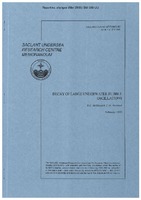| dc.contributor.author | McDonald, B. Edward | |
| dc.contributor.author | Holland, Charles W. | |
| dc.date.accessioned | 2018-10-11T14:08:51Z | |
| dc.date.available | 2018-10-11T14:08:51Z | |
| dc.date.issued | 1999/02 | |
| dc.identifier | 12181 | |
| dc.identifier.govdoc | SM-356 | |
| dc.identifier.uri | http://hdl.handle.net/20.500.12489/523 | |
| dc.description.abstract | Pressure - time series from breathing mode oscillation of large (centimeter scale or larger) underwater bubbles reveal much higher decay rates than can be explained using viscous, thermal, or radiative mechanisms which apply to microbubbles. We show that if one assumes energy transfer to shape | |
| dc.description.abstract | oscillations (surface capillary waves) of large amplitude in subharmonic resonance with the breathing mode [Longuet - Higgins, JASA 91, 1414, 1992), then the shape oscillations can drive fluid motions outside the bubble capable of exciting turbulent instabilities. Application of an appropriate eddy viscosity from mixing length theory to the viscous decay mechanism appears to offer a credible explanation for the observed large decay rates. We give an analysis to show that energy is transferred from the breathing mode to surface capillaries fast enough to make the proposed decay mechanism viable. | |
| dc.format | vi, 14 p. : ill. ; 4 fig. | |
| dc.language | English | |
| dc.publisher | NATO. SACLANTCEN | |
| dc.subject | Bubbles | |
| dc.subject | Underwater explosions | |
| dc.subject | Underwater implosions | |
| dc.subject | Underwater acoustics | |
| dc.title | Decay of large underwater bubble oscillations | |
| dc.type | Scientific Memorandum (SM) | |
